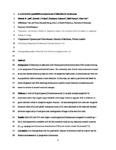A novel tool for quantitative measurement of distortion in keratoconus
| dc.contributor.author | Joshi, Mahesh Raj | |
| dc.contributor.author | Voison, KJ | |
| dc.contributor.author | Piano, M | |
| dc.contributor.author | Farnon, N | |
| dc.contributor.author | Bex, PJ | |
| dc.date.accessioned | 2022-11-07T13:28:05Z | |
| dc.date.issued | 2022-09-14 | |
| dc.identifier.issn | 0950-222X | |
| dc.identifier.issn | 1476-5454 | |
| dc.identifier.uri | http://hdl.handle.net/10026.1/19897 | |
| dc.description.abstract |
BACKGROUND: Keratoconus is associated with thinning and anterior protrusion of the cornea resulting in the symptoms of blurry and distorted vision. The commonly used clinical vision tests such as visual acuity and contrast sensitivity may not reflect the symptoms experienced in keratoconus and there are no quantitative tools to measure visual distortion. In this study, we used a quantitative test based on vernier alignment and field matching techniques to quantify visual distortion in keratoconus and assess its relation to corneal structural changes. METHODS: A total of 50 participants (25 keratoconus and 25 visually normal) completed the experiment where they aligned supra-threshold white target circles in opposite field in reference to guidelines and circles to complete a square structure monocularly. The task was repeated five times and the global distortion index (GDI) and global uncertainty index (GUI) were calculated as the mean and standard deviation respectively of local perceived misalignment of target circles over five trials. RESULTS: Both GDI and GUI were higher in participants with keratoconus compared to controls (p < 0.01). Both parameters correlated with the best corrected visual acuity, maximum corneal curvature (Kmax), topographical keratoconus classification (TKC) and central corneal thickness (CCT). CONCLUSION: Our findings show that the quantitative measure of distortion could be a useful tool for behavioural assessment of progressive keratoconus. | |
| dc.format.extent | 1788-1793 | |
| dc.format.medium | Print-Electronic | |
| dc.language | en | |
| dc.language.iso | eng | |
| dc.publisher | Springer Science and Business Media LLC | |
| dc.subject | Humans | |
| dc.subject | Keratoconus | |
| dc.subject | Corneal Topography | |
| dc.subject | Cornea | |
| dc.subject | Visual Acuity | |
| dc.subject | Vision, Ocular | |
| dc.title | A novel tool for quantitative measurement of distortion in keratoconus | |
| dc.type | journal-article | |
| dc.type | Journal Article | |
| plymouth.author-url | https://www.webofscience.com/api/gateway?GWVersion=2&SrcApp=PARTNER_APP&SrcAuth=LinksAMR&KeyUT=WOS:000854705800002&DestLinkType=FullRecord&DestApp=ALL_WOS&UsrCustomerID=11bb513d99f797142bcfeffcc58ea008 | |
| plymouth.issue | 9 | |
| plymouth.volume | 37 | |
| plymouth.publication-status | Published | |
| plymouth.journal | Eye | |
| dc.identifier.doi | 10.1038/s41433-022-02240-x | |
| plymouth.organisational-group | /Plymouth | |
| plymouth.organisational-group | /Plymouth/Faculty of Health | |
| plymouth.organisational-group | /Plymouth/Faculty of Health/School of Health Professions | |
| plymouth.organisational-group | /Plymouth/REF 2021 Researchers by UoA | |
| plymouth.organisational-group | /Plymouth/REF 2021 Researchers by UoA/UoA03 Allied Health Professions, Dentistry, Nursing and Pharmacy | |
| plymouth.organisational-group | /Plymouth/Users by role | |
| plymouth.organisational-group | /Plymouth/Users by role/Academics | |
| dc.publisher.place | England | |
| dcterms.dateAccepted | 2022-09-05 | |
| dc.rights.embargodate | 2023-3-14 | |
| dc.identifier.eissn | 1476-5454 | |
| dc.rights.embargoperiod | Not known | |
| rioxxterms.versionofrecord | 10.1038/s41433-022-02240-x | |
| rioxxterms.licenseref.uri | http://www.rioxx.net/licenses/all-rights-reserved | |
| rioxxterms.licenseref.startdate | 2022-09-14 | |
| rioxxterms.type | Journal Article/Review |


